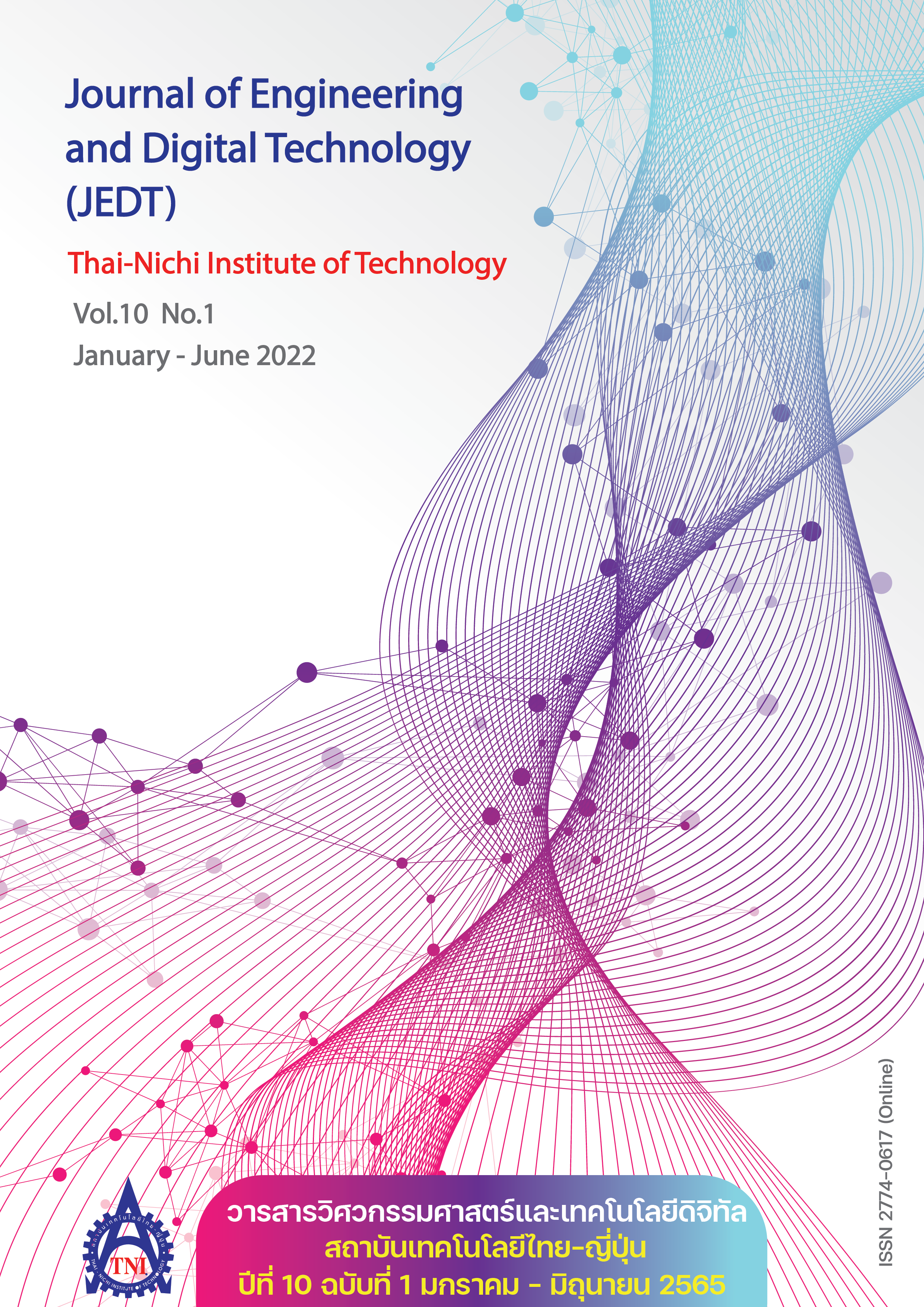Development of Rapid Prototyping for Ceramic Products Using Layer Manufacturing Technique
Main Article Content
Abstract
This research aims to design and develop a rapid prototyping machine and explore the forming parameters, included the performance evaluation of rapid prototyping machine technology for ceramic products which deploy layer manufacturing technique. Procedural of this research started from 3D ceramic product design in Unigraphics NX version 6.0 program, next created a cross section line in the 3D file base on a height of product at each layer in development a rapid prototyping machine. The machine size is 300×400×500 millimeter which is composed of 3 components, 1) Base structure 2) Injection rate control unit 3) Electronic control system and software. In wiring electronic circuit, RNR Motion board is applied. USB port used as communication port between hardware and Mach3 CNC controller software is used to control the motor moving in 4 axes as X, Y, Z and A. Testing has explored to find the effective parameters to create prototype. The control parameters are diameter size of injector which is fixed at 2 millimeters, and PBB compound clay which contained the moisture range as 40-50%. The dependent parameters are injector rate, velocity and interval of forming level. The testing results shown that the appropriate injection rate is 5 mm/min, the velocity of axes moving in x, y, z is 60 mm/min, the appropriate interval of forming level is 0.80 millimeter and results of circle forming style, rectangle forming style and free style forming production are good performed, after put the forming product into flaming with 1200 Celsius, the forming product is perfect, no rupture and no twisted. The performance of rapid prototyping machine is measured by product size after forming, found that the mean of +/- deviation is 0.2 millimeter.
Article Details

This work is licensed under a Creative Commons Attribution-NonCommercial-NoDerivatives 4.0 International License.
Article Accepting Policy
The editorial board of Thai-Nichi Institute of Technology is pleased to receive articles from lecturers and experts in the fields of engineering and technology written in Thai or English. The academic work submitted for publication must not be published in any other publication before and must not be under consideration of other journal submissions. Therefore, those interested in participating in the dissemination of work and knowledge can submit their article to the editorial board for further submission to the screening committee to consider publishing in the journal. The articles that can be published include solely research articles. Interested persons can prepare their articles by reviewing recommendations for article authors.
Copyright infringement is solely the responsibility of the author(s) of the article. Articles that have been published must be screened and reviewed for quality from qualified experts approved by the editorial board.
The text that appears within each article published in this research journal is a personal opinion of each author, nothing related to Thai-Nichi Institute of Technology, and other faculty members in the institution in any way. Responsibilities and accuracy for the content of each article are owned by each author. If there is any mistake, each author will be responsible for his/her own article(s).
The editorial board reserves the right not to bring any content, views or comments of articles in the Journal of Thai-Nichi Institute of Technology to publish before receiving permission from the authorized author(s) in writing. The published work is the copyright of the Journal of Thai-Nichi Institute of Technology.
References
S. Inthaput, Competitiveness of Thai ceramics industry. Bangkok, Thailand: Department of Export Promotion, (in Thai), 2003. Accessed: Feb. 16, 2022. [Online]. Available: https://www.ditp.go.th/contents_attach/78351/78351.pdf
N. Travitzky et al., “Additive manufacturing of ceramic-base materials,” Adv. Eng. Mater., vol. 16, no. 6, pp. 729–745, 2014.
J. Garden, “Additive manufacturing technologies: state of the art and trends,” Int. J. Prod. Res., vol. 54, no. 10, pp. 3118–3132, 2016.
S. B. M. Patzelt, B. C. Spies, and R. J. Kohal, “CAD/CAM-fabricated implant-supported restorations: a systematic review,” Clin. Oral Implants Res., vol. 26, no. S11, pp. 77–85, 2015.
A. Christ, R. Heister, and R. Anderl, “Reverse engineering for the utilization of product model data for CAx workflows in dental technology,” in Proc. 20th Eur. Concurrent Eng. Conf. - 10th Future Bus. Technol. Conf., Bruges, Belgium, Apr. 2014, pp. 47–54.
J.-Y. Lee, J. An, and C. K. Chua, “Fundamentals and applications of 3D printing for novel materials,” Appl. Mater. Today, vol. 7, pp. 120–133, Jun. 2017.
Q. Liu, M. C. Leu, and S. M. Schmitt, “Rapid prototyping in dentistry: technology and application,” Int. J. Adv. Manuf. Technol., vol. 29, pp. 317–335, Jun. 2006.
H. Shao, D. Zhao, T. Lin, J. He, and J. Wu, “3D gel-printing of zirconia ceramic parts,” Ceram. Int., vol. 43, no. 16, pp. 13938–13942, Nov. 2017.
P. Pitayachaval and A. Thongrak, “A study of slope edge of technology,” in Proc. 38th Ind. Eng. Netw, Chon Buri, Thailand, 2020, pp. 255–259.
F. Yang, M. Zhang, B. Bhandari, and Y. Liu, “Investigation on lemon juice gel as food material for 3D printing and optimization of printing parameters,” LWT - Food Sci. Technol., vol. 87, pp. 67–76, Jan. 2018.
S. Otarawanna, “The use of 3D printing technology in manufacturing industry,” (in Thai), J. Mater. Technol., vol. 85, pp. 24–28, 2017. [Online]. Available: https://www2.mtec.or.th/th/e-magazine/admin/upload/303_24.pdf


